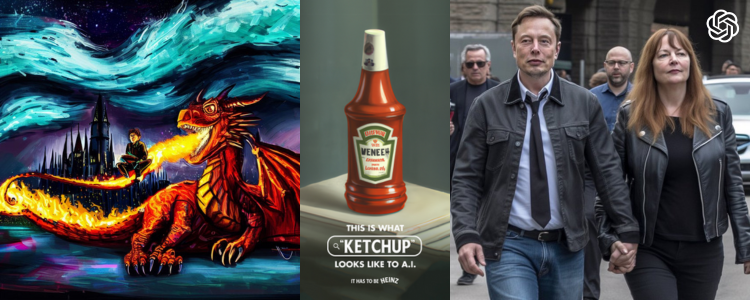During the late 19th century, Vincent van Gogh made some of the most impressive art of the era. Known for his post-impressionist style, the artist soon became famous for his works such as The Starry Night, Sunflowers, and Bedroom in Arles. Not only is his art spectacular to look at, the artist’s unique style was also challenging to replicate. Until now.
Fast forward more than a hundred years and introduce DALL·E, a generative AI model designed to create images from textual descriptions. Using DALL·E, practically anybody can be their own Van Gogh (or any other artist for that matter). Do you want to have an image of Harry potter on a dragon near Hogwarts in the same style as the famous artist from the 19th century? No problem.
DALL·E uses a large dataset that consists of image and text pairs to understand the relationship between text and visual content. When you provide the generative AI with a prompt, it first tries to understand the text, after which it creates a corresponding image (Heaven, 2021). The unique feature is that the AI is boundless, meaning that it can practically create anything that your imagination comes up with.
But what good does it do us? Advertising agency Rethink cleverly used DALL·E in one of its campaigns for Heinz, where the AI was asked to generate images that included ketchup. The majority of the returned images show the iconic Heinz ketchup bottle, illustrating DALL·E’s comprehension of ketchup and, consequently, our perception of it (Rethink Communications, 2022).
However, every rose has its thorn, and that same applies to DALL·E too. The generative AI tool raises several ethical questions, such as the use of the technology in spreading fake news (Kahn, 2023). As an example, a realistic yet fake image depicted Elon Musk holding hands with Mary Barra, the CEO of General Motors, implying the two were in a relationship (Reuters Fact Check, 2023). The speed at which these images can be created and shared is concerning, as fact checkers do not have time to debunk everything before it gains traction. Moreover, further ethical questions are raised concerning the fact that anyone can generate images of real people without their consent (Taylor, 2022).
Nevertheless, when we can overcome the challenges of generative AI, it proves a powerful tool in our everyday lives. I encourage you to try the technology yourself. What are your thoughts on generating images using AI? Where do you think it will be most effective? And what should we do to minimize the risks?
References
Heaven, W. D. (2021, Januray 5). This avocado armchair could be the future of AI. Retrieved from MIT Technology Review: https://www.technologyreview.com/2021/01/05/1015754/avocado-armchair-future-ai-openai-deep-learning-nlp-gpt3-computer-vision-common-sense/
Kahn, G. (2023, April 11). Will AI-generated images create a new crisis for fact-checkers? Experts are not so sure. Retrieved from Reuters Institute: https://reutersinstitute.politics.ox.ac.uk/news/will-ai-generated-images-create-new-crisis-fact-checkers-experts-are-not-so-sure
Rethink Communications. (2022). Heinz A.I. Ketchup. Retrieved from Rethink: https://rethinkideas.com/work/heinz-ketchup/2022/digital-social/heinz-a-i-ketchup/
Reuters Fact Check. (2023, March 30). Fact Check-Image of Elon Musk and Mary Barra holding hands is AI-generated. Retrieved from Reuters: https://www.reuters.com/article/factcheck-elon-musk-mary-barra-idUSL1N3621JN
Taylor, J. (2022, June 18). From Trump Nevermind babies to deep fakes: DALL-E and the ethics of AI art. Retrieved from The Guardian: https://www.theguardian.com/technology/2022/jun/19/from-trump-nevermind-babies-to-deep-fakes-dall-e-and-the-ethics-of-ai-art


Although I do believe in the potential DALL-E has on image creation, some things should be taken into consideration when looking into the artistic world. Yes, DALL-E will in the future be able to create beautiful images that represent the particular styles of artists like Van Gogh but how does it effect the value of these images created by DALL-E versus the original paintings? This is where I think we will see some limitations of generative AI regarding the valuation of art as the value of an image or painting is also determined by the story of its creation. To elaborate, generative AI doesn’t experience life like a real person would, so it isn’t able to replicate the inherent value behind the art of a real artist. So while artists might use generative AI as a tool to help them, generative AI will never completely replace the need for real artists due to the inherent value they are able to create.
I think you are posing some interesting questions. I think that we have had many ways throughout history to create fake news that have been ‘advanced’ in relation to the technology that was available at that time. For example, when the only information available was word-of-mouth, then a simple lie could be seen as fake news. If someone writes an email in someone else’s name, that can be seen as fake news. In a way every form of technology has a way of enabling people to create fake news. Thus, I think the fact that AI is a fairly unknown technology means that we do not have an overview yet of what kind of fake news it can create and in what format. This makes it unpredictable and scary for now, however I think that when some time passes we will comprehend it better and we will be able to put processes in place to regulate the phenomeon of AI generated fake news.
I am not saying that there are no dangers, but I am trying to point out that our fear comes from the fact that we do not know what we are supposed to be scared of. I also wanted to point out that even though it is a new technology, it is not a new phenomenon. So caution is important, but I do not think we have to be scared.
I really liked the topic of your post and I thought the questions posed were very thought-provoking. Thank you!